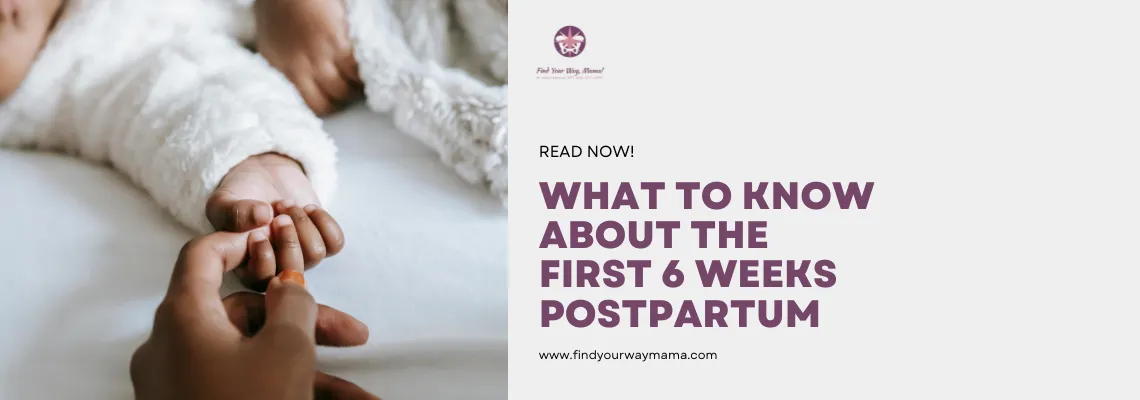
What is going on with your body the first 6 weeks after the baby?

Our bodies go through many changes during pregnancy. Our body continues to go through transformation after baby arrives.
If you recently had a baby or are about to you likely have heard of the 6 week wait. We are given a short list of what not to do during the first 6 weeks after baby:
no sex or any vaginal penetration
no exercise
no swimming or bathing
However we aren’t often told what is going on with our body during that time. Why we should avoid those activities. What you can expect. And most importantly what we can do during those first 6 weeks. Well, it’s time to change that! Here are 7 key things to know about the six week wait.
You will have vaginal bleeding the first 6 weeks after baby.
It generally takes 6 weeks for bleeding to stop.
Regardless of if you had a vaginal birth or a caesarean birth you will experience bleeding postpartum. This discharge is a mix of blood, tissue and mucus and is called lochia. It is shed from the inside of the uterus as the uterus heals and begins to replace its lining.
Lochia starts as bright red and may contain clots and gradually will change to brown to pale yellow as it decreases in volume. Bleeding usually stops at 6 weeks although it can last for 8 weeks and on rarer occasions up to 12 weeks postpartum.
While bleeding is normal during this time, it can also indicate if you are overdoing it. If you have a sudden increase in bleeding this can indicate that you are doing too much, and should return to its typical amount with some rest. Please make sure you communicate with your MD or midwife if you notice bleeding becoming heavier over time instead of lighter, excessive clots or large golf ball sized clots, dizziness with position change, heavy bleeding where you need to change a pad every hour, foul odor, green discharge, or vaginal swelling.
During the first 6 weeks after baby your uterus will return to it’s pre-pregnancy size
Your uterus expands a great amount throughout your pregnancy. By the end of the 3rd trimester it expands from pelvis to ribcage and the American Pregnancy Assoc. describes it as the size of a watermelon.
It took nine months to expand to that size, it will take time to return to it’s pre-pregnancy size and shape. Generally it takes six weeks for this to occur although it can take up to 8 weeks for some. During your six week visit with your provider they will check to see if your uterus has completed the process of involution (the returning to normal size.)
As your uterus shrinks so does the wound left behind from the placenta detaching. This wound becomes smaller as the tissue heals (more on that in a moment) and also by the fact that the surface area inside the uterus becomes less as the organ gets smaller.
This happens through contractions. Yes, you will still experience contractions after birth. This is something a lot of new moms are not prepared for. They can be quite uncomfortable feeling like early stage labor contractions.
Breastfeeding helps encourage these contractions and helps facilitate the process of involution. If you are choosing to breastfeed you will notice more frequent contractions while actively breastfeeding.
6 weeks for tissue healing
As previously mentioned tissue healing needs to occur to shrink the size of the wound in the uterus. It takes about 6 weeks for this wound healing to occur. This is also the time line for incisions to heal as well. So if you had a caesarean birth or an episiotomy 6 weeks is what you can expect for timeframe for your incision to be closed and sutures dissolved.
Keep in mind that when talking about 6 weeks being the time for your tissue to be healed we are referring to the wound or incision being closed. Scar tissue continues to form for several more weeks and then remodeling needs to occur. Tissue remodeling can take several months to two years to complete!
Hormones start to shift back to pregnancy levels 6 weeks after baby
Our hormones are always in a state of fluctuation. This is normal and to be expected. Right after birth progesterone and estrogen drop drastically once the placenta is delivered. Oxytocin and prolactin increase rapidly.
Around 6 weeks after birth our hormones begin to shift again and oxytocin begins to decrease. If not breastfeeding prolactin will also start to decrease at this time back towards it’s pre-pregnancy levels. While this adjustment is starting to occur around 6 weeks you might notice the return of your period, mild hair loss and you may also notice signs of postpartum depression.
Hair loss from hormonal shifts
Mild hair loss is normal and usually resolves around 6 months postpartum as your hormones continue to return to pre-pregnancy fluctuations. If you notice clumps of hair coming out at once, if it seems significant to you or if it lasts longer than a year are all reasons to talk to your physician, you might want to have thyroid and other hormone levels tested.
Postpartum mood disorders
Drastic drops in sex hormones may play a role in postpartum depression and mood disorders but are not the whole story. A 2016 study looked at the role of these hormone fluctuations and postpartum depression (PPD). The hormone fluctuations that happen postpartum might play a role by being one of several triggers and causes that results in postpartum depression. There appears to be a hormone sensitive phenotype for postpartum depression where the hormone fluctuation is the sole trigger for the presentation of PPD.
Postpartum mood disorders generally start to appear around 6 weeks and can appear until around 18 months postpartum. If you are noticing any signs of postpartum depression or anxiety let your provider. If you feel you are in crisis, having thoughts of harming your self or your baby call your provider’s emergency line, you can also call 988 if in the US.
Signs of postpartum depression
depressed mood or severe mood swings
hopelessness
withdrawing from family and activities you previously enjoyed
difficulty bonding with your baby
severe anxiety
worried you aren’t a good mother, intense shame and guilt
difficulty sleeping and intense fatigue (beyond that from decreased sleep due to baby)
restlessness
thoughts of harming your self or your baby
thoughts your baby is better off without you
Please note this is just a sample list and this should be discussed with your medical doctor. The reasons for postpartum mood disorders go beyond hormone fluctuations and can have a variety of causes. It is important to have a thorough workup
While hormones start returning to normal around 6 weeks but don’t fully return to pre-pregnancy patterns until closer to 6 months if formula feeding. This takes longer if breastfeeding.
Exercise is restricted but movement is not those 1st 6 weeks
When we are told to avoid exercise what we should be told is to avoid high impact activities and heavy lift and that we should generally take it easy. While we don’t want a new mom back at her Crossfit box or Soul Cycle during this time we do want to encourage gentle movement.
Most moms who had vaginal deliveries report whole body fatigue and soreness after birth and C-section moms have their own challenges. Gentle movement can promote blood flow to help rid the body of lactic acid build up creating that sore feeling. Improved blood flow from walking is an essential part of recovery from surgery. Walking can decrease your risk of blood clots after surgery and promote recovery.
Gentle movement goes beyond a gradually progressed walking program postpartum. It is important to address thoracic (upper back) and rib cage mobility, ease hip, low back and pelvic floor tension and restore proper breathing patterns. Gentle movement can help with all of that.
Not sure where to start? Grab Your Postpartum Plan with therapeutically progressed gentle movements designed just for you! You absolutely can (and should!) embrace these exercises to give yourself the head start you deserve in your recovery. Let’s pave the way to feeling stronger, more balanced, and empowered together!
This is also a great reason to see a pelvic floor/ postpartum physical therapist early on. Especially if you plan on returning to exercise once you are “cleared.” Seeing a PT in the first 6 weeks is strongly recommended if you had a C-secrtion. Even if it is for one or two visits. If you are in MA (north of Boston) give me a call. I’ll come out to see you where you’re at.

Rest and nutrition are important
These are two key elements for healing that are often overlooked postpartum. As you just read our bodies are healing postpartum! This is especially true if you needed a c-section, which is a major surgery, that often isn’t treated as such.
Rest is vital during the 6 weeks after baby
We need to balance out rest with gentle movement. Don’t panic this doesn’t mean solid 8 hours of sleep. That just isn’t realistic in early motherhood, normal baby sleep doesn’t allow for it. What it does mean is focusing on quality sleep over quantity and prioritizing rest where you can.
This can look like having your partner take over diaper changes at night, or rocking baby back to sleep after a feeding. If you are bottle feeding you can split the night with your partner. This can also look like. having a trusted friend/family member or even a doula spend 30-60mins with baby mid-day so you can nap. It also can look like laying down with baby for 10 minutes after you get back from a walk. Most importantly, letting go of your “shoulds” and to-do list this 1st 6 weeks.
Keep nutrition in mind those first 6 weeks after baby
When our bodies are healing: wound healing, muscle tears. ect; we need more calories. These calroies should have an emphasis on our protein intake (unless of course you have a medical reason where you should avoid protein.) Quality fats support our hormones and carbs can boost our energy as well as serotonin. I hope you can see how all three macronutrients are very important for postpartum healing.
If a mom is attempting to breastfeed she further needs increased well balanced calories, around 500 additional calories.
Our micronutrient intake is also important. Micronutrients are the vitamins and minerals that our body needs for optimal function. Pregnancy and postpartum are nutritionally demanding on the mother and can lead to depletion of many nutrients. A study published in Nutrients Journal in 2019 demonstrates that women with VitD deficits might be at higher risk of PPD. Vitamin D also plays an important role in your immune system and your energy levels, so being low on VItD can have several negative affects.
Iron also plays a role in your energy level and wound healing and according to Alison Boden of Motherwell Nutrition is the most common deficiency postpartum and WHO estimates 42% of new mothers are anemic.
It is important to continue to take your prenatal vitamin after baby arrives, there are also some brands that formulate a postpartum blend. Talk to your physician or dietitian on if you need additional supplements or dietary recommendations. You can always have your levels checked.
Regardless of if you are breastfeeding or not postpartum is NOT a time to start dieting or cutting calories. It is important to prioritize hydration, whole foods that are nourishing and protein.

6 weeks is just the beginning
Our bodies go through so many changes throughout our pregnancy, these changes do not stop postpartum. Our bodies are working hard to heal and return towards pre-pregancy homeostasis during those first 6 weeks after baby. While changes happen rapidly during those first 6 weeks, it is really just the beginning. There is no magic that happens by your 6 week visit. The transformation of your body, hormones and transition into motherhood is long lasting. You can and should prioritize your healing, seek support and understand that postpartum is a transition that does not happen over night.
Thank you for sharing!
Struggling with postpartum pelvic pain, leaks, or discomfort? Download your FREE Postpartum Pelvic Recovery Guide and learn simple, expert-backed strategies to heal, strengthen, and feel like yourself again. Because your recovery matters—let’s take care down there!
